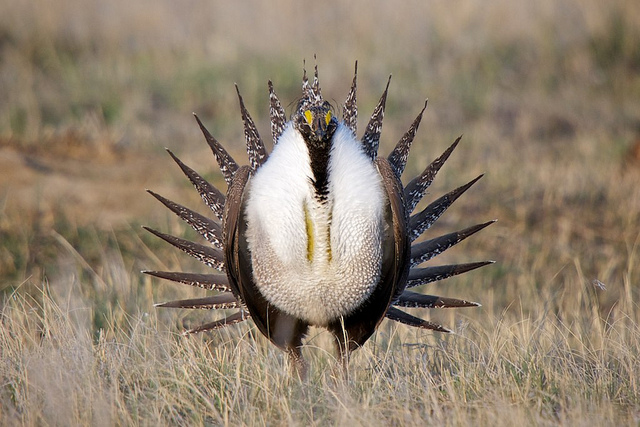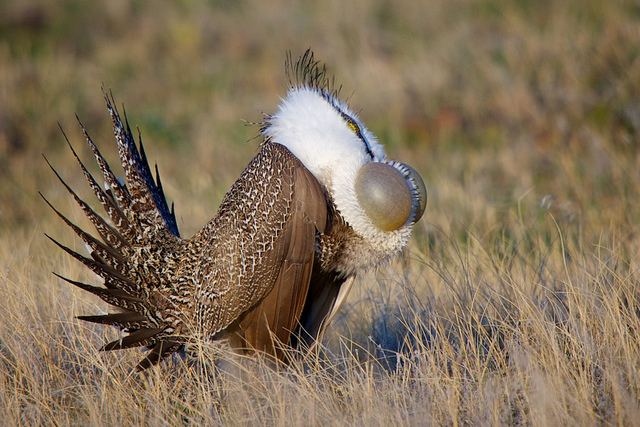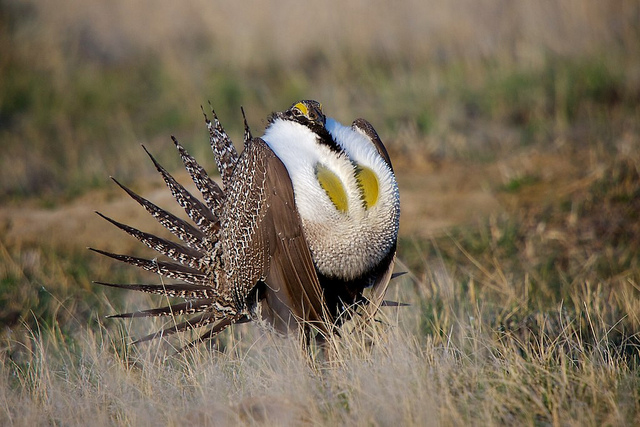BirdNote © Sage Grouse
Air Date: Week of March 15, 2013

Greater Sage Grouse (© Randy Kokesch)
In spring, male Greater Sage-Grouse go to traditional areas, called leks and compete to lure females to mate with elaborate and noisy displays. But as Michael Stein reports, the birds are endangered.
Transcript
CURWOOD: Well, as Sarah Uhlemann noted, habitat loss is a major threat to many creatures - including one of our very own - the Greater Sage-Grouse. The US Fish and Wildlife Service has concluded the birds do need Endangered Species Act protection, but other creatures are even more threatened, so they'll have to wait. Meantime, as Michael Stein explains in today's BirdNote®, Sage-Grouse put on a wonderful show.
STEIN: Dawn breaks across the sagebrush country of the West on a brisk March morning.
[SAGE-GROUSE MALES PERFORMING]

Greater Sage Grouse (© Randy Kokesch)
Already, fifteen male Greater Sage-Grouse are strutting on their traditional display area, a sparsely vegetated arena amid the sage.
[SAGE-GROUSE MALES PERFORMING]
As the sun rises, meadowlarks begin to sing.
[WESTERN MEADOWLARK SONG]
And we can now see the Sage-Grouse clearly. The enormous males are over two feet long, and weigh six pounds. They stand bolt upright, their long tails fanned like a turkey’s tail, the dark backs and bellies contrasting sharply with their white breasts. When they display, the sage-grouse simultaneously scrape their wings back and forth against their flanks, expel air from twin, fleshy chest-sacs the size of tennis balls, and call softly. The resulting sound combines swishing, popping, and cooing.
[SOUNDS OF SAGE-GROUSE MALES PERFORMING ON LEK]
At the display area, known as a lek, the male Sage-Grouse perform for mating rights with the smaller females looking on.
[SOUNDS OF SAGE-GROUSE MALES PERFORMING ON LEK]
As lands formerly covered in sage are converted to agriculture, so goes the fate of the magnificent Sage-Grouse. In some areas, the grouse have less than ten percent of their historical range.
[SOUNDS OF SAGE-GROUSE MALES PERFORMING ON LEK]

Greater Sage Grouse (© Randy Kokesch)
I’m Michal Stein
CURWOOD: To see some photos of the Sage-Gouse and leks, strut on over to our website loe.org.
[Written by Bob Sundstrom
Bird sounds provided by The Macaulay Library of Natural Sounds at the Cornell Lab of Ornithology, Ithaca, New York. Display sounds of the Greater Sage-Grouse recorded by G.A. Keller; call of the Western Meadowlark recorded by W.R. Fish
Producer: John Kessler
Executive Producer: Chris Peterson
© 2013 Tune In to Nature.org March 2013 Narrator: Michael Stein]
Links
Living on Earth wants to hear from you!
Living on Earth
62 Calef Highway, Suite 212
Lee, NH 03861
Telephone: 617-287-4121
E-mail: comments@loe.org
Newsletter [Click here]
Donate to Living on Earth!
Living on Earth is an independent media program and relies entirely on contributions from listeners and institutions supporting public service. Please donate now to preserve an independent environmental voice.
NewsletterLiving on Earth offers a weekly delivery of the show's rundown to your mailbox. Sign up for our newsletter today!
 Sailors For The Sea: Be the change you want to sea.
Sailors For The Sea: Be the change you want to sea.
 The Grantham Foundation for the Protection of the Environment: Committed to protecting and improving the health of the global environment.
The Grantham Foundation for the Protection of the Environment: Committed to protecting and improving the health of the global environment.
 Contribute to Living on Earth and receive, as our gift to you, an archival print of one of Mark Seth Lender's extraordinary wildlife photographs. Follow the link to see Mark's current collection of photographs.
Contribute to Living on Earth and receive, as our gift to you, an archival print of one of Mark Seth Lender's extraordinary wildlife photographs. Follow the link to see Mark's current collection of photographs.
 Buy a signed copy of Mark Seth Lender's book Smeagull the Seagull & support Living on Earth
Buy a signed copy of Mark Seth Lender's book Smeagull the Seagull & support Living on Earth

